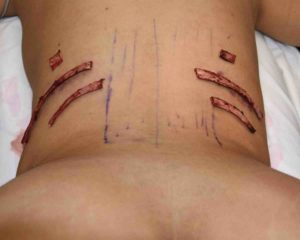Rib removal is most commonly known for its effect on helping reduce the anatomic waistline or waistline slimming . Usually the ribs that are partially removed (outer halves) are #s 11 and 12. This is because these are the true free floaters and are pointed 45 to 60 degrees straight downward. Once one realizes the true orientation of these two ribs compared to all of the ribs above them, it is easy to understand why they would be effective in helping to narrow the anatomic waistline.
Rib #10, like #11 and #12, are part of the five false ribs but differ from the two below them. It is oriented slightly more horizontal and wraps around the waistline to a cartilaginous connection to the rib above it. This still makes its management useful in anatomic waistline reduction but just not as much as the lower two free floater ribs.

Rib removal for waistline slimming uses two basic approaches to the ribcage, subtotal outer half rib removal and rib arch reduction techniques. These are different than how many people perceive rib removal as the complete removal of the rib which just not how it is done.
Dr. Barry Eppley
Indianapolis, Indiana


